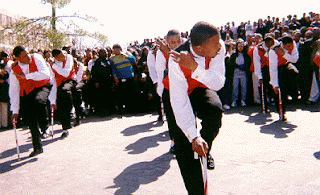 |
| Members of the Kappa Beta Chapter of Kappa Alpha Psi Fraternity, Inc perform a step show at the University of Memphis in 1999 Note that the average cane is about knee high (app. 2 feet), image source at site |
Topics: African Americans, History, Diaspora, Diversity in Science, Women in Science
Stepping, like the blues, gospel, grits, jazz, be-bop, soul music, rock & roll and hip hop has its origins in traditions passed down from mother to daughter; father to son. It's originated in the 19th century in the form of South African gumboot dancing. The black miners were forbidden drums and traditional garb by the foremen, so they used as a way to break up the monotony, entertainment and communication with the only instruments they had: their rain boots and their bodies. It evolved from call-and-response sermons in black churches: "the rhythm of clap and tambourine, washboard and kettle drum." You can see certain tribes on the Mother Continent today that the only name you can give their rhythmic stomping, their pirouettes, their sheer expression of joy... is stepping.
It is an American art form, found in all of the Divine Nine, taught to undergrads and in some cases graduate initiates to carry on a tradition that on the outside looks almost stereotypical to the cynical, that usually will make snide and racist remarks out of ignorance because they do not understand.
They obviously haven't read "Invictus" by William Ernest Henley, nor understood the conditions under which he wrote his words:
Henley's literary reputation rests almost entirely upon this single poem.[7] In 1875 one of Henley's legs required amputation due to complications arising from tuberculosis. Immediately after the amputation he was told that his other leg would require a similar procedure. He chose instead to enlist the services of the distinguished English surgeon Joseph Lister, who was able to save Henley's remaining leg after multiple surgical interventions on the foot.[8]
While recovering in the infirmary, he was moved to write the verses that became "Invictus". This period of his life, coupled with recollections of an impoverished childhood, were primary inspirations for the poem, and play a major role in its meaning.[9] A memorable evocation of Victorian stoicism—the "stiff upper lip" self-discipline and fortitude in adversity, which popular culture rendered into a British character trait, "Invictus" remains a cultural touchstone.[6] Source: Wikipedia, see second Invictus link.
Invictus is memorized and recited by initiates to the Divine Nine as well as majority organizations, but not without the cultural backdrop of being and living in America as almost an afterthought. It's about pushing ahead through adversity; fighting against mighty streams of resistance to one's goal.
In a conversation I recounted with Dr. Ronald E. McNair (A&T physics graduate and sadly, Challenger astronaut casualty), "5 weeks before his dissertation defense, someone purged his data (also known as sabotage). Without data, he'd essentially have failed to get his PhD. He said he stayed up for 3 weeks and re-accomplished 5 years of research. He slept for a week after that." He was a proud member of Omega Psi Phi, a member of the Divine Nine. He obviously learned, and LIVED Invictus. I'll wager because he was a jazz saxophonist and an accomplished athlete (part of the Fighting Aggie Karate Team, and 5th Degree Black Belt) he STEPPED as an undergrad, too.
Most of the Founders of African American Fraternities and Sororities were men and women of letters, but also (at least for the initial organizations) as undergraduates servants within dominate frat and sorority houses. Due to segregation, they were not allowed to join majority organizations. It was under these and similar circumstances the germ of an idea: organizations of our own was born.
It is why such organizations step, while others do not.
It is an expression of triumph over adversity from a society designed against you to be at times vindictively cruel and punitive.
It is rising above bigoted circumstances; winning in spite of low expectations and outright, malicious sabotage.
It is, with or without canes, martial arts, break dancing, gymnastics, music and pirouettes the embodiment of Langston Hughes classic poem, I'm Still Here:
Sun has baked me,
Looks like between 'em they done
Tried to make me
Stop laughin', stop lovin', stop livin'--
But I don't care!
I'm still here!
I am the captain of my soul.
William Earnest Hensley, last stanza of "Invictus"
Still here, unconquered AND stepping to prove it!
Related Links:
Step Afrika: What is Stepping?
The Art of Stepping: History of the Art of Stepping
University of Florida Multicultural Guide: What is Strolling?
Wikipedia: Gumboot dance
Wikipedia: Stepping (African-American)
Kappas on YouTube (Hey, I'm a member, so I'm GOING to be partial):
Howard Homecoming
Maniac Drew Brown (Cane Master)
Southern Province Step Show
The Art of Twirling
University of Miami, TEDx
Comments